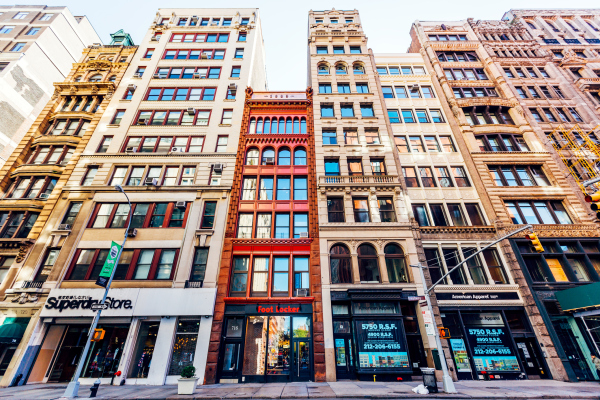
The pandemic made the internet a lifeline for shopping, earning a living and maintaining personal relationships. Now, as lockdowns start to lift, the real estate industry has to figure out what that means.
Seeking answers, I surveyed the people who are betting on the biggest and most surprising changes in the sector — proptech investors. While landlords and their lenders may hope for a return to the past, proptech investors are focused on where the notion of place is going in the future. I have an in-depth writeup with many excerpts and my thoughts over on TechCrunch, including a look at the revival of neighborhood retail, the rebirth of cities and much more.
I couldn’t get into all of the great topics, though, including the rapid recent evolution of the residential sales and rental market, construction tech, related climate-tech topics and other issues.
So here are the thousands of words of answers in full, below. Extra Crunch subscription required. If you’re a startup founder, employee, investor, etc., you may also enjoy the previous editions of this survey, from the fall of 2020, spring of 2020 and fall of 2019.
The investors we talked to:
- Clelia Warburg Peters, venture partner, Bain Capital Ventures
- Christopher Yip, partner and managing director, RET Ventures
- Zach Aarons, co-founder and general partner, MetaProp
- Casey Berman, general partner, Camber Creek
- Vik Chawla, partner, Fifth Wall
- Adam Demuyakor, co-founder and managing partner, Wilshire Lane Partners
- Robin Godenrath and Julian Roeoes, partners, Picus Capital
- Stonly Baptiste, founding partner, and Shaun Abrahamson, managing partner, Urban Us
- Andrew Ackerman, managing director, Dreamit
Clelia Warburg Peters, venture partner, Bain Capital Ventures
As the pandemic hopefully enters its final stages, how are the changes from this period affecting your real estate and proptech investment strategy? Are big trends of the present, like high nationwide housing demand and mass commercial vacancies, refocusing your investing strategy?
Above all, I think COVID will prove to be an accelerant to existing trends in both the residential and commercial space. I like to think of it as a decade of innovation acceleration in 24 months.
The pandemic has certainly refocused attention on life at home, and that combined with low interest rates has undeniably made this an incredible period for companies that touch the housing market. Given that I got into proptech through work at a family residential brokerage, this market has always been a big area of interest for me, and I would observe that we were in the midst of some major shifts in this market pre-COVID. The residential transaction disruption is now settling in three core categories: iBuyers (who buy homes directly from sellers and ultimately hope to own the sell-side marketplace), neobrokers (who generally employ their agents and use secondary services such as title mortgage and insurance to increase their revenue) and elite agent tools (platforms or tools focused on the top agents). Additionally, consumers are increasingly open to alternative financing tools, including home-equity-based financing models (where you sell a stake in your home, or you buy into full ownership in a home over time. The growth and proliferation of these new models are consolidating the whole residential market so that brokerage sales commissions and commission from the sale of mortgage, title and home insurance are now functionally one large and intertwined disruptable market. In this context, while some of the valuations we are seeing may be a little euphoric, I think there is no doubt that we are in a period of massive and sustainable innovation in how we buy and hold our homes and I think these trends are going to be enduring.
In the commercial arena, we were also in the midst of a meaningful shift in how companies were conceiving of office space, in many ways thanks to the innovations that WeWork brought to the market. But the pandemic has pushed this much further, fundamentally shifting the relationship between the landlord/manager (who has largely been in a position of power since the 1950s) and the tenant (who is now in a position of much greater power, more akin to a consumer of a luxury product). As a result of this, I think the best landlords will recognize that they are going to be under pressure to shift from simply providing a physical space, to helping provide tenants with a multichannel work experience. This might mean a physical/digital hybrid of systems that include access control, physical space management (both in the hub location and potentially in spoke locations), and a digital space for meetings and collaboration. These assets will need to be provided in the context of a much more human relationship, focusing on serving the needs of tenants. As lease terms inevitably shorten, tenants will need to be courted and supported in a much more active way than they have been in the past.
How do you see the big cities adapting to life after the pandemic — or will they? What solutions are you focusing on in particular for the future of urban living (co-living, ADUs, commercial conversion to residential, etc.)?
I think the experience of cities after the pandemic is going to be highly variable — for instance, the trajectories for Austin and New York will likely look radically different. I am personally uncertain about how co-living, or even commercial to residential conversion will be at play, but I do believe that there will be a few consistent areas of interest.
First, smaller-scale urban life will continue to be a significant trend. I think we will continue to see a proliferation of bike lanes, a focus on living in walkable neighborhoods, and a reliance on tools (such as the app Nextdoor) that reinforce our feeling of connection to our neighbors.
Second, I think we will continue to see a reliance on certain types of outsourced services — ghost kitchens for takeout or rapid provision of groceries and other essentials — and technologies and spaces that facilitate these will be a growth area.
Finally, I do believe that in some more sprawling urban environments ADUs will be an area of growth, particularly with seniors who are looking for an additional income stream so they can age at home. One caveat is that I think this will be something of a winner-takes-all space with a limited number of geographically dominant winners.
The demand for suburban-style living is back — for now. What are you focusing on across this category for the next year or two (new residential services and amenities, build-to-rent housing developments, etc.)?
The current transition out of urban environments and into suburban environments is playing out alongside some broader changes in the way the American public seems to be approaching homeownership. Over the past decade, there has been a net decline in homeownership and a net growth in renting. Some of this is by necessity, and some is by choice. I think one component of the tech-related opportunity in the migrations we see now will be around rental platforms and multifamily amenitization. There is still no data aggregator like the MLS on the rental side, and a number of portals (including Zillow Rentals, Apartment List, Zumper, RentalBeast and others) are competing to provide listing information to consumers. On the multifamily side, many multifamily operators are understanding that the integration of work/life/play is creating a new need for amenitization and greater services in their offerings. I think we will continue to see more and more emphasis on hospitality-style brand creation in the multifamily space, and much of this will be facilitated by different kinds of tech-facilitated amenities.
It’s also important to note the flood of both institutional and private investor money that is coming into the single-family rental space. (It may be that in the future a certain percent of the population is renting their primary home, but exposed to the property market through ownership of these kinds of real estate assets.) This growth is being facilitated by property management services like Mynd, marketplaces like Roofstock, and innovative products like Zibo or Knox Financial.






